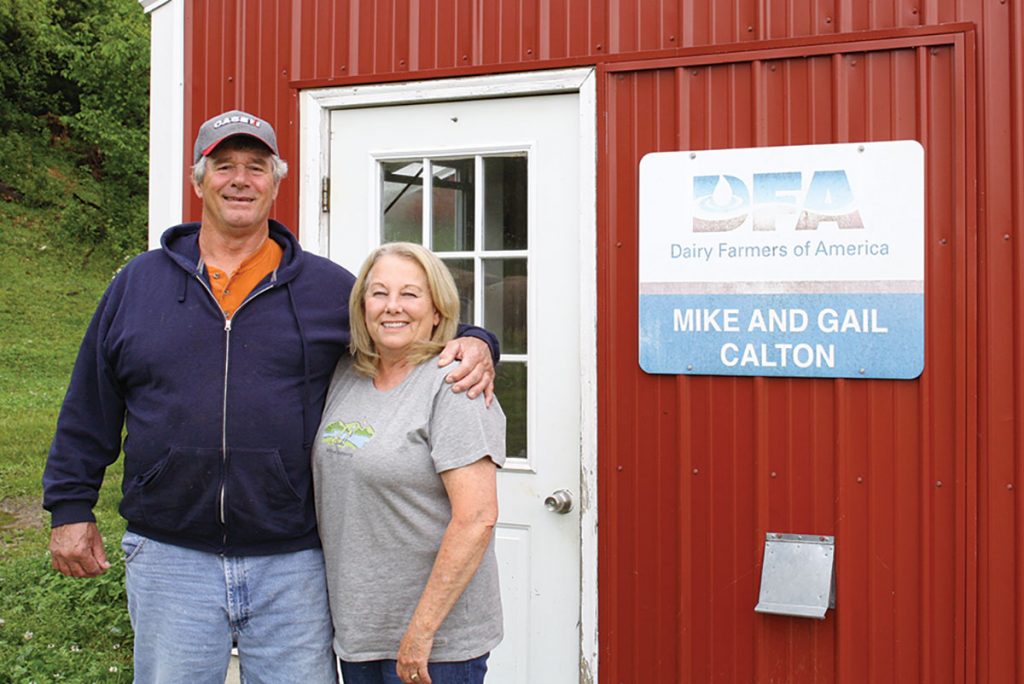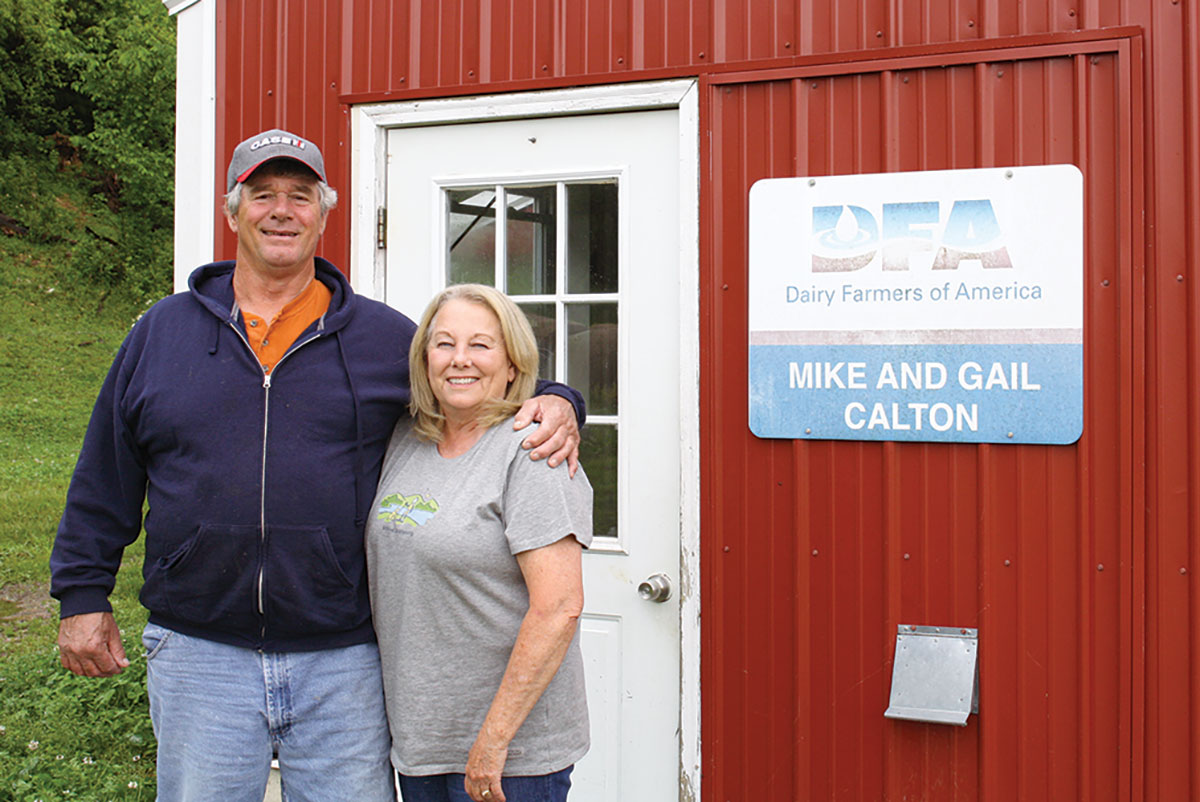
Dairy farming is more than making a living for Mike Calton. It’s been his way of life his entire life.
“I was born and raised on a dairy farm; this dairy farm,” Mike said, adding that his family settled the original farm in 1857.
Mike and Gail milk 70 Holsteins, with an additional 70 replacement heifers of various ages.
The dairy is pasture-based, meaning cows only get grain twice a day inside the milk barn. The 400-acre farm can pasture all of the cows, as well as supply the majority of the grass hay needed.
“We don’t get record setting production like some of the TMR (total mixed ration) guys, but we have a lot of pasture and hay ground, so that works for us,” Mike said. “We try to keep the labor to a minimum and round bales are about as good as it gets for us. We could do silage and a TMR, but it’s not something we have ever gone to.”
Their herd averages about 50 pounds daily, and it climbing to 60 or 70 pounds in the spring.
For a few years, Mike did plant green graze and wheat.
“We used to plow up and disk a lot of land,” Mike said. “It would take quite a bit now to plow up a good stand of grass.”
The cows at Calton Dairy graze on fescue, orchardgrass, clover and other native grasses. There is a rotational system in place, but Mike said it is not meant to be an intensive grazing system.
“We can move our cattle around the way we want to,” he said. “Right now we have everything off the bottoms because we’re going to hay it. Keeping them off the hay ground messes things up a little, but those Holsteins eat a lot of hay.”
As a forage-based dairy, Mike feels his cows are productive longer and it’s a more economic way to operate.
“I could go for higher (milk) averages, but it costs more to do that,” he said.
Mike’s father Wallace Calton began milking in the early 1950s and was the first farm in the area to incorporate an AI program, which Mike continues today.
“My dad was a big Holstein man and was really the first man to bring top-quality Holsteins into the area, and we’ve been doing it for 70 years,” Mike said.
“I’ve stuck with Holsteins because it would be a shame to change that now.” “If you go to the sale barn, if you have the big, fancy Holstein springer heifers, they bring the most. Mixed little Jersey or crosses will sell well, but the top ones are the big, fancy Holsteins.”
The Calton reputation for quality Holsteins continues today. Mike and Gail sell several breed heifers to fellow dairy producers.
“AI has immensely added to the genetics of our cattle,” Mike said. “We’ve been doing it so long now that we can sell our bulls. My neighbor up the road, I’ve been selling him bulls for 30 years and all of his cows are out of my bulls. When you drive out and look at his herd they are just as nice as ours. We usually sell a group of springers or milk cows a year, but we haven’t the last couple of years because of the price. We have sold a lot of cattle right off the farm; we kind of have a name for that. People can come in, pick out the cows they want and we have had good luck with that. I always tell the local dairymen I sell to if they aren’t happy they can bring her back and get a different cow; I guarantee them. I usually try to sell the best I’ve got because they are all good. I don’t have any problem parting with any cow.”
He hasn’t had a single cow returned.
“People are happy with the cows they have gotten,” Gail added.
Mike has a set pattern he likes to follow with his cattle.
“We want a cow with good udder support, good feet and legs, and I like medium-sized cows that are good grazers,” he explained. “If they don’t have a good udder, they aren’t going to be around for long; a few years and they are done.”
If the quality or health of the cow is low or subpar, so is the quality of the milk, which is why Mike is committed to quality above all.
Last year, Calton Dairy was eighth in the region for milk quality out of 410 dairies.
“We are usually in the top 10 for milk quality,” Mike said. “Our most recent (somatic) cell count was 118,000. The top one in the state was right at that.”
Overall health can also be attributed to a close relationship with the veterinarians at Marshfield Vet.
“They have improved the profitability on our farm. It can be expensive when you call them, but it’s worth it,” Mike said. “If (cows) don’t clean after calving, I hate to call them out for that, but getting that cow cleaned up, taken care of and on the right track is so important.”
The Caltons also utilize the service to preg check cows, as well as for overall herd health, including vaccinations.
They also believe in giving all calves a healthy start.
“We put the calf in a pen right by the milk barn, so the calf has its mother’s milk for three to five days,” Gail said. “Three years from now, that heifer will be milking with her momma.”
Mike and Gail have been dairy farmers for their entire marriage.
The couple recently celebrated their 46th wedding anniversary. They have two sons, Kelley and Chad, and three grandchildren, Jarrett, Carly and Jeffrey.
“I didn’t know anything about dairy farming,” Gail, who moved to the Ozarks in 1972 from St. Louis, said.
“Thousands of calves later, she knows a lot about it now,” Mike added with a laugh.
Gail, who retired three years ago after a 25-year career as a teacher in the Lebanon, Mo., school district, admits she hasn’t spent too much time in the milk barn, but she loves the farming way of life.
“I had weekend duty with calves when I was teaching,” Gail said. “Now I’m in charge most of the time.”
With their roots firmly planted in the dairy business, the Caltons did something few producers have done in recent years. They built a new milk barn.
“It’s so efficient,” Mike said. “Plus, it has heat and air. It’s easy to clean and I love it. Stainless steel stalls with automatic feeders, you just flip a switch,” Mike said. “The very first barn was the barn I milked in with my dad. It just a three on-the-side walkthrough with homemade wooden stalls. It was pretty crude. Down the road, where my son, Kelley, lives, we build a three–on-the-side bypass. Now I have a herringbone and it’s really a nice barn.”
“He deserves it and if that’s what makes him comfortable, then do it,” Gail said.
The dairy industry is a tough one for many producers, especially smaller producers like the Caltons, and they admit there have been struggles, including times when Mike had to take work off-the-farm at the former Mid-Am facility in nearby Lebanon.
“As long as I can scratch out a living, I’m going to keep doing it, Mike said. “I don’t think anyone has enjoyed milking cows more than I have and it’s a steady check. It might not be much, but it comes every two weeks. We’ll keep milking. Small farms like ours are almost a thing of the past.”
“There’s still a place for small dairies,” Gail added.








What a wonderful article about a wonderful couple.